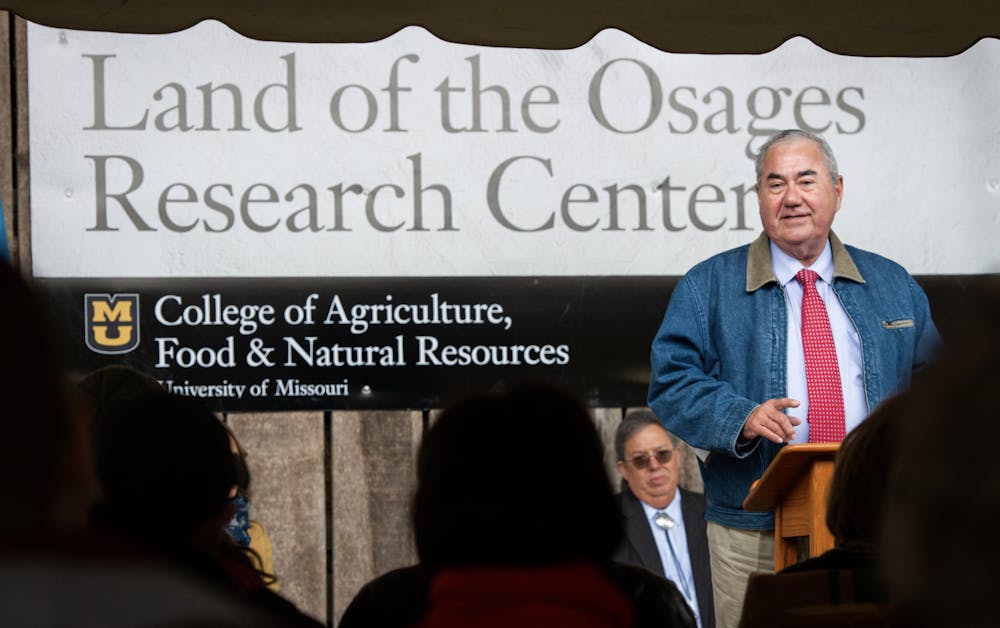Principal Chief Geoffrey Standing Bear discussed his experience navigating federal laws and relationships as Principal Chief of the Osage Nation in Oklahoma at a talk on Tuesday, Nov. 29, in Aaron Burr Hall.
Chief Standing Bear recently won the election for his third term as the head of the government of the Osage Nation. According to his page on the Osage Nation website, he “continues the work of protecting and enhancing the Osage culture, language, and lands.”
“Chief Standing Bear governs the 1.5 million acre lake Osage reservation in northeastern Oklahoma,” Chair of Anthropology João Biehl said in his introduction for the event.
Chief Standing Bear opened by explaining the current situation of the Osage Nation’s relationship with the U.S. government.
“It is important to understand that we seek a government-to-government relationship,” he said. “It would be a dream to be independent, but what we seek and what we demand is co-governance over our territories.”
When he assumed his current role in 2014, Chief Standing Bear said he sought to enhance the sovereignty of the Osage Nation through territorial acquisition, language maintenance, and cultural practices.
“Although we [had] … 1.5 million acres in 1906, we were down to under 150,000 acres when I took office in 2014, so acquiring land and territory was high on our agenda,” he said.
Chief Standing Bear said that he has made significant progress on these goals, adding over 50,000 acres to the Osage Nation during his tenure.

Describing some of the events that take place in the ceremonial centers built during his time as Principal Chief, he said, “You will see 300 men and 300 women dancing in our full regalia.”
Another important aspect of Osage culture is food, Chief Standing Bear told the attendees.
“Something that we’re very proud of is that our foods, like the other tribes, contain so much of our history and culture,” Chief Standing Bear said, quipping that “my grandmother said you’re Indian, and you need to eat meat.”
The Osage Nation has faced meat shortages during the COVID-19 pandemic, he said. Chief Standing Bear said that in March 2020, “there was no food in the stores and there was no food in the suppliers.”

To address the issue, Chief Standing Bear initiated the construction of a new meat processing plant by hiring architects and engineers, and by bringing in employees from two other tribes to help.
“COVID was horrible and it affected us terribly. But it was great to see us come together,” he said.
He described how the Osage Nation government was able to take advantage of the federal Coronavirus Aid, Relief, and Economic Security (CARES) Act to build the meat processing plant.
“We began to process over 60 head of cattle per month,” he said. These facilities also allowed them the ability to process bison again, which they hadn’t been able to do for 150 years, according to Chief Standing Bear.
The Osage Nation also recently built two 20,000 square foot greenhouses and started both a farmers market and an aquaponics farm, increasing access to fresh meat and vegetables.
Still, the Osage Nation faces continued challenges in working with the federal government. Chief Standing Bear described recent conflicts over land rights and how he decided to terminate the Osage Nation’s participation in the Federal Head Start program, which provided the tribe with funding for education, because it didn’t allow for a native language program. With new educational freedom, Chief Standing Bear borrowed a native language program from a neighboring tribe in New Mexico, which he said has seen great success.
“We were down to a handful of fluent speakers, and now in a short period of . . . less than two years we have over 100,” he said.
Chief Standing Bear said the tribe continues to face the challenge of Osage Indians leaving the reservations in rural Oklahoma for larger cities with job opportunities. Moreover, the Osage Nation constantly faces threats to its sovereignty. Chief Standing Bear said Kevin Stitt, the recently re-elected governor of Oklahoma, believes that “all of [Oklahoma] needs to have one set of laws and rules.” Two recent Supreme court cases — McGirt v. Oklahoma and one concerning the Indian Child Welfare Act (ICWA) — have posed threats to the Osage Nation’s sovereignty.
Even in spite of these challenges, Chief Standing Bear said he remains optimistic about the future. “In a lot of ways our prayers have been answered,” he said. “We’ve got meat, we’ve got food, we’ve got a lot of challenges, so I feel really good about the future.”
The event was sponsored by the Department of Anthropology and Native Graduate Students of Princeton, and co-sponsored by the Pace Center for Civic Engagement, the University Center for Human Values, the Native American and Indigenous Studies Initiative at Princeton, the Carl A. Fields Center for Equality, the Liechtenstein Institute on Self-Determination, and The Graduate School.
The talk was held at 4:30 p.m. on Tuesday, Nov. 29 in Aaron Burr Hall.
Chas Brown is a news contributor for the ‘Prince.’ Please direct any corrections to corrections[at]dailyprincetonian.com.
Correction: a previous version of this article stated that the event was sponsored by multiple different groups. In fact, this event was sponsored primarily by the Department of Anthropology and Native Graduate Students of Princeton. The ‘Prince’ regrets this error.








